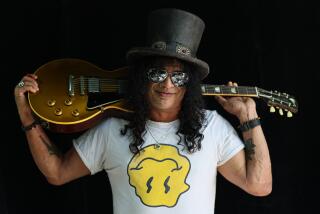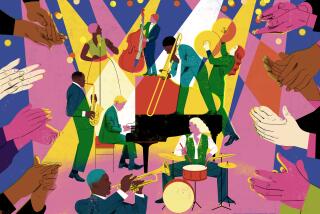Bassist Has a ‘Together’ Attitude : Jazz: Bruce Lett says the key to making music really come alive is the players doing ‘the right thing at the right time.’ He’s in Corona del Mar tonight.
- Share via
Bassist Bruce Lett has a nifty paraphrase of the adage that says, “It’s the singer, not the song” that counts. To Lett, it’s the players, not the genre.
“I don’t understand hating a particular style of music. You can get a rush playing any type, if it’s done right,” Lett said. He should know--he works in bands that play funk, jazz-fusion, straight-ahead jazz, R&B;, Dixieland, bossa novas and pop tunes.
“I just worked a Christmas party with a great rhythm section, and we burned it up. It was just as much fun as anything else I’ve done,” said Lett, 38, who also leads a combo tonight and every Thursday at the Studio Cafe in Corona del Mar.
The key to making the music really come alive is “playing the right thing at the right time together . . . that makes you feel great,” the bassist said during a recent phone interview from his home in Lakewood.
Another element that makes music worth playing is challenge, Lett said. That’s one aspect he finds appealing about his 2 1/2-year engagement at the Studio Cafe. There, he and his cohorts--singer Christine Day, drummer-singer Ralph Dudley and keyboardist John Brainard--deliver mostly R&B-based; material, such as versions of tunes recorded by Stevie Wonder, Anita Baker, Chaka Khan and others.
“We take a lot of chances with the music,” said Lett, who also regularly performs with drummer Alphonse Mouzon’s fusion band, fluegelhornist Tony Guerrero, drummer Les Czimber’s trio and Bill Holman’s jazz orchestra. He can be heard on “The Bill Holman Band,” a 1988 album on JVC Records. “We treat a lot of these tunes differently every night, maybe change the tempo or the style, like doing Stevie’s ‘You Are the Sunshine of My Life’ as a fast samba or even straight-ahead swing.”
Improvisation is another important facet in the music Lett performs at the club.
“Each of us has a jazz background, and that can’t help but have that influence on the music,” said Lett, who attended Indiana State University at Evansville from 1972 to ‘73, the University of Oklahoma in 1974, and the renowned jazz-based North Texas State University in Denton, Tex., from 1975 to ’79. “We stretch these tunes out, and take a lot of solos.”
Audiences “see how we’re taking liberties and getting creative, and they enjoy it,” said Lett, a native of Evansville, Ind., who moved to Southern California in 1985.
The band might even be making jazz fans out of customers who ordinarily wouldn’t listen to jazz. “Since the music is very accessible, we’re reaching listeners who don’t understand jazz, who maybe wouldn’t be reached by some pure jazz,” says Lett, whose playing is distinguished by a resilient tone and buoyant rhythmic attitude.
Lett, whose playing is distinguished by a resilient tone and buoyant rhythmic attitude, said there’s no longer one single role for a bass player in any style of music.
“The role has been expanded greatly to include everything from providing the rhythmic and harmonic foundation of a tune to being a solo instrument,” he said.
His sees his job in the rhythm section at the Studio as pretty similar to that of a funk-band bassist.
“It’s up to me to lay down a groove, a rhythmic pattern that will make the other musicians feel good and will make the listener move or pat his foot,” he said. “Of course, I want to play together with the drummer. Whatever groove I’m setting, he will want to go with that, maybe accenting it with his bass or snare drum.”
In straight-ahead jazz, the process is somewhat different, Lett said. “Again, you want a consistent feel so the soloist will be comfortable, but it’s important to outline the structure of the chord progression that the tune is built on. In funk, the accent is more on being rhythmic.”
It’s not easy switching between electric bass, which he plays at the Studio and with Mouzon, and the upright, acoustic instrument, which he plays with Holman and Czimber, Lett said. “They’re different animals, especially the way you play the neck, as I do with my left hand. On the upright, you use three fingers; on electric, you use four, and all the scales are fingered differently.”
Jumping styles can be tough, too, “You want to be as good as you can, no matter what you’re doing,” he says. “And each style requires a lot of practice.”
Lett studied piano and clarinet as an adolescent and was in the seventh grade when he heard a band playing Beatles tunes at a school performance. The incident changed him forever.
“The crowd went nuts listening to these guys, and I said, ‘That’s what I want to do,’ ” he recalled.
A year later, Lett was playing bass with a group called Chocolate Haystack, which from 1966 to 1971 traveled throughout Indiana, Illinois and Kentucky, playing renditions of tunes recorded by the Beatles, Rolling Stones, Jimi Hendrix, as well as Motown hits. Playing for sock hops and college parties, the band considered itself quite successful. “We made good money: $35 to $40 a night,” Lett said.
Enrolled at Indiana State University at Evansville, Lett began playing the upright bass and discovered jazz. First it was guitarist Barney Kessel. Then he worked a gig at a country club, playing such standards as “Satin Doll” and “Stardust.”
“I didn’t know what I was doing, but the piano player was patient,” Lett said. “He told me to get an Oscar Peterson record with Ray Brown on bass, and I took Ray’s bass lines off the record and learned how to play jazz that way.”
Formal studies with Murray Grodner at Indiana and John Williams at Oklahoma prepared Lett for the whirlwind of activity he encountered at North Texas State.
“I knew when I got there that I wanted to be a performer, so I went to school part time,” Lett said. “A typical day would be to practice from 8 in the morning until noon, then rehearse with the One O’Clock Lab Band (the school’s top ensemble), then jam in the afternoon, and work a job that night.”
After four years at North Texas, Lett found it a natural move to enter the lucrative studio recording scene in Dallas. But after five years, he found the work boring.
“It wasn’t challenging, and Los Angeles seemed like it would be,” he said.
Arriving here seven years ago, Lett was soon in demand. He joined Holman’s band, subbed for John Patitucci on jobs in Orange County and became a regular on the party and wedding circuit.
“I know a thousand tunes, some of those stupid pop tunes,” he said. “If you know the tunes, you can get work.”
Sometimes, though, the work is slow, as in January, or, he jokes, “on a Monday when I haven’t worked that weekend.” Then Lett has second thoughts about his career. “I think, ‘Maybe I should have taken up home building.’ But, hey,” he added with a laugh, “that’s slow now, too.”
* Bruce Lett’s band plays tonight and every Thursday from 9 p.m. to 12:30 a.m. at the Studio Cafe, 3201 E. Pacific Coast Highway, Corona Del Mar. Admission: free. Information: (714) 675-7575.
More to Read
The biggest entertainment stories
Get our big stories about Hollywood, film, television, music, arts, culture and more right in your inbox as soon as they publish.
You may occasionally receive promotional content from the Los Angeles Times.










